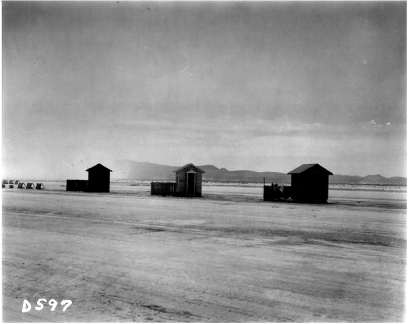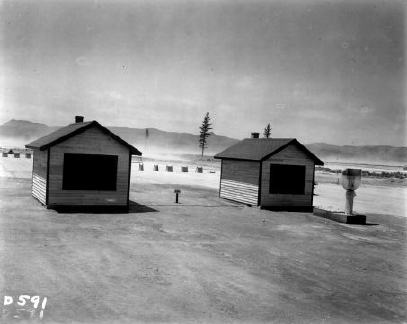WHOLE WORLD ON FIRE:
ORGANIZATIONS, KNOWLEDGE,
& NUCLEAR WEAPONS DEVASTATION
by LYNN EDEN
(Ithaca: Cornell University Press, 2004)


U.S. atmospheric nuclear weapons tests conducted in the 1950s enabled the government to build knowledge about nuclear weapons effects. These tests focused far more on blast damage than on fire damage. When fire damage was studied, it was examined at the small scale of house fires, not at the large scale of mass fires (commonly called firestorms). As a result, the physics of mass fire from nuclear weapons was not explored, though the physics formed the necessary basis for predicting fire damage from nuclear weapons.
At Operation UPSHOT-KNOTHOLE, Shot ENCORE, a 27 kiloton detonation, was held at the Nevada Test Site on May 8, 1953. Both "The House in the Middle" and "Two Block Houses" took place at this shot. (An excellent film showing these experiments can be found on the PRELINGER ARCHIVE, HOUSE IN THE MIDDLE.) In both, wooden structures were exposed to the heat of the detonation, measured in calories per square centimeter. As you look at the slide shows, keep in mind that the outside edge of the firestorm at Hiroshima occurred at 10 calories per square centimeter. The photographs from Shot ENCORE were purchased as prints from what is now the Nevada Site Office. They are public domain, and you are free to use them. Simply say "Photo courtesy of National Nuclear Security Administration / Nevada Site Office."
Previously, at Operation UPSHOT-KNOTHOLE, the nationally-televised Shot ANNIE, a 16 kiloton detonation, was held on March 17, 1953. The Federal Civil Defense Administration (FCDA) had projects here termed "Operation DOORSTEP." Two wood-frame houses-"House No. 1" and "House No. 2"-along with backyard shelters and "fifty automobiles of various types, colors, and operating conditions" were exposed to the effects of the bomb "to show the people of America what might be expected if an atomic burst took place over the doorsteps of our major cities." Shown here is House No. 1. According to Samuel Glassone's authoritative THE EFFECTS OF NUCLEAR WEAPONS(1957), "Since the tests were intended for studying the effects of blast, precautions were taken to prevent the houses from burning. The exteriors were consequently painted white.... The windows ... were equipped with metal venetian blinds having an aluminum finish.... The houses were roofed with light gray shingles ... of asbestos cement.... There were no [gas or electrical utilities of any kind." These are some of the most famous nuclear test pictures ever taken. They were obtained electronically from the NEVADA SITE'S very good photo library. Again, these photos are public domain. The credit is the same as above.
These experiments, as well as several others, are discussed in detail in WHOLE WORLD ON FIRE, chapter 6.
Click below to access slideshows


